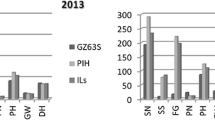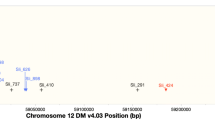Abstract
In this study, we describe a novel ecological self-incompatibility (SI) line HE97 in maize. The main environmental factors influencing the inbred line characteristics were identified through field sowing trials during a two-year study period (2001 and 2002). The results showed that daily minimum temperature had the greatest effect on floral morphology and breeding system of the SI line. In staminate floret differentiation, when the daily minimum temperature exceeded 24°C, the line exhibited complete self-compatibility; however SI was observed when the daily minimum temperature was below 20°C. Therefore, we characterized the line as exhibiting thermo-sensitive genic self-incompatibility (TGSI). A set of F2 and F2:3 populations, derived from the inbred lines HE97 and Z58, were evaluated for two years to elucidate the TGSI line patterns of inheritance. Classical genetic analyses and QTL mapping results revealed that HE97 self-incompatibility was governed by a single allele, named here astgsi1. Thetgsi1 gene was mapped to chromosome 2 between SSR markers nc131 and bnlg1633, with a distance of 2.40 cM from nc131 and 2.44 cM from bnlg1633.
Similar content being viewed by others
References
Baumann U, Juttner J, Bian XY andLangridge P (2000) Self-incompatibility in the grasses. Ann. Bot. 85 (Supplement A): 203–209.
Cao B, Zhang SJ, Cao SC andZhao ZH (2005) Research report of regression relationship between leaf number index and spike differentiation in maize (In Chinese with English abstract). Journal of Maize Science 13: 86–88.
Clarke A andNewbigin E (1993) Molecular aspects of selfincompatibility in flowering plants. Annu. Rev. Genet. 27: 257–279.
Dickinson HG (1995) Dry stigmas, water and self incompatibility in Brassica. Sex. Plant Reproduction 8: 1–10.
Denna DW (1971) The potential use of self- incompatibility for breeding F1 hybrids of naturally self-pollinated vegetable crops. Euphytica 20: 542–548.
Dodds PCA andNewbigin E (1996) A molecular perspective on pollination in flowering plants. Cell 85: 141–144.
Fu TD (2000)Breeding and utilization of rapeseed Hybrid, 2nd edn., Hubei Science and Technology Press, Wuhan, 257 pp.
Guan CY (2001) The self-incompatibility characteristics and heterosis breeding on rape (in Chinese with English abstract). Journal of Hunan environment biological polytechnic 7: 1–6.
Hackauf B andWehling P (2005) Approaching the self-incompatibility locus Z in rye (Secale cereale L.) via comparative genetics. Theor. Appl. Genet. 110: 832–845.
Horisaki A andNiikura S (2008) Developmental and environmental factors affecting level of selfincompatibility response inBrassica rapa L. Sexual Plant Reproduction 21: 123–132.
Kendall WA andTaylor NL (1969) Effect of temperature on pseudo-self-compatibility in Trifolium pretense L. Theor. Appl. Genet. 39: 123–126.
Koelling VA andKeith K (2007) Self-pollen interference is absent in wild radish (Raphanus raphanistrum, Brassicaceae), a species with sporophytic selfincompatibility. American Journal of Botany 94: 896–900.
Koprna R, Kučera V, Kolovrat O, Vyvadilová M andKlíma M (2005) Development of self-incompatible lines with improved seed quality in winter oilseed rape (Brassica napus L.) for hybrid breeding. Czech J. Genet. Plant Breed 41: 105–111.
Lander ES, Green P, Abrahamson J, Barlow A, Daly MJ, Lincoln SE andEtoh T (1987) MAPMAKER: an interactive computer package for constructing primary genetic linkage maps of experimental and natural populations. Genomics 1: 174–181.
Liang XL andZhang ZH (1995) Studies on the relation between panicle initiation and leafage in maize. J. South China Agri. Univ. 16: 83–87.
Liedl BE, McCormick S andMutschler MA (1996) Unilateral incongruity in crosses involvingLycopersicon Pennellii andesculentum L. is distinct from selfincompatibility in expression,timing and location. Sex. Plant. Reprod. 9: 299–308.
Matton DP, Maes O andLaublin G (1997) Hypervariable Domains of Self-Incompatibility Rnases Mediate Allele-Specific Pollen Recognition. The Plant Cell 9: 1757–1766.
Matton DP, Nass N, Clarke A andNewbigin E (1994) Self-incompatibility: How plants avoid illegitimate offspring. Proc. Natl. Acad. Sci. USA 91: 1992–1997.
Nasrallah J, Stein J, Kandasamy M andNasrallah M (1994) Signaling the arrest of pollen tube development in self-incompatible plants. Science 266: 1505–1508.
Nikornpun MA, Li Z andPayakhapaab E (2004) The uses of self-incompatibility genes on Chinese cabbage. Southwest China Journal of Agricultural Sciences 17: 217–223.
Shen JX, Wang HZ, Fu TD andTian BM (2008) Cytoplasmic male sterility with self-incompatibility, a novel approach to utilizing heterosis in rapeseed (Brassica napus L.) Euphytica 162: 109–115.
Stam P (1993) Construction of integrated genetic linkage maps by means of a new computer package: JoinMap. Plant J. 3: 739–744.
Subudhi PK, Bortatati RP andVirmani SS (1997) Molecular mapping of a thermo sensitive genic male sterility in rice using bulked segregant analysis. Genome 40: 188–194.
Sun WC, Liu ZG, Meng YX, Zhang T, Zeng XC, Wang HL, Wang BC andShao DK (2004) Overcoming self-incompatibility inEurca sativa Mill. Via chemical treatment (in Chinese with English abstract). Chinese journal of oil crop Sci. 26: 8–11.
Tang JH, Fu ZY, Hu YM, Li JS, Sun LL andJi HQ (2006) Genetic analyses and mapping of a new thermosensitive genic male sterile gene in maize. Theor. Appl. Genet. 113: 11–15.
Tang JH, He ZY, Tan SY, Chen WC, Hu YM, Liu ZH andLi YL (2000) Study on the fertility conversion mechanism of the temperature-sensitive genic male-sterile line in maize (In Chinese with English abstract). J. Henan Agri. Univ. 34: 4–6.
Townsend CE (1968) Self-compatibility studies with diploid alsike clover, Trifolium hybridum L. III. Response to Temperature. Crop Sci. 8: 269–272.
Townsend CE andDanielson RE (1968) Nontranslocation of temperature-induced self-compatibility substances(s) in alsike clover,Trifolium Hybridum L. Crop Sci. 8: 493–495.
Walker JC andZhang R (1990) Relationships of putative receptor protein kinase from maize to the S-locus glycoproteins of Brassica. Nature 345: 743–746.
Wang YG, Xing QH, Deng QY, Liang FS, Yuan LP, Weng ML andWang B (2003) Fine mapping of the rice thermo-sensitive genic male-sterile gene tms5. Theor. Appl. Genet. 107: 917–921.
Wang CH, Zhang P, Ma ZR, Zhang MY, Sun GC andLing D (2004) Development of a gentic marker linked to a new thermo-sensitive male sterile gene in rice (Oryza sativa L.). Euphytica 140: 217–222.
Wilkins PW andThorogood D (1992) Breakdown of self-incompatibility in perennial ryegrass at high temperature and its uses in breeding. Euphytica 64: 65–69.
Xing QH, Ru ZG, Zhou CJ, Xue X, Liang CY, Yang DE, Jin DM andWang B (2003) Genetic analysis, molecular tagging and mapping of the thermosensitive genic male-sterile gene (wtms1) in wheat. Theor. Appl. Genet. 107: 1500–1504.
Yamagushi Y, Ikeda R, Hirasawa H, Minami M andUjihara P (1997) Linkage analysis of the thermo-sensitive genic male sterility genetms2 in rice (Oryza sativa L.). Breed Sci. 47: 371–377.
Zeng B (1994) Precision mapping of quantitative trait loci. Genetics 136: 1457–1468.
Zhang R andWalker JC (1993) Structure and expression of the S locus-related genes of maize. Plant Mol. Biol. 21: 1171–1174.
Author information
Authors and Affiliations
Corresponding author
Rights and permissions
About this article
Cite this article
Lin, X., Xie, H., Xi, Z. et al. Identification and mapping of a thermo-sensitive genic self-incompatibility gene in maize. Genes & Genomics 31, 227–234 (2009). https://doi.org/10.1007/BF03191194
Received:
Accepted:
Issue Date:
DOI: https://doi.org/10.1007/BF03191194




